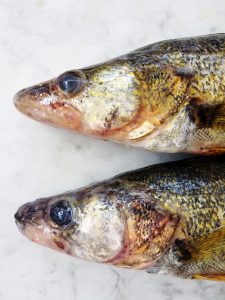If life gives you fish, make Gefilte!
In the food world and in the seafood world specifically, there are many timeless traditional meals that spark nostalgia while simultaneously creating new memories. We’re talking about Gefilte fish!
This cold dish is traditionally enjoyed during the Jewish holiday of Passover with a simple accompaniment of sliced, cooked carrot and grated horseradish sweetened with beet sugar.
So what exactly is Gefilte fish, and why are there two prominent variations?
Gefilte fish is basically a poached fish meatball or galantine. Traditionally speaking, this dish is preferred to be made from live (or freshly butchered) fish consisting of Grass Carp, Whitefish, and Yellow Pike; which are all fresh water fish. But, those particular fish were utilized because of the affordable price. In today’s market you can use whatever fish suits your fancy. Keep in mind, as with most food items, the better quality fish – the better the results, as long as they are Kosher.
There are two major flavor profiles for Gefilte fish: savory/peppery and sweet. It started off in the early 19th century, when sugar was a prized commodity and too expensive to put in cheaper food so everyone cooked savory. It wasn’t until the Polish started manufacturing beet sugar that the game changed and people started making sweet preparations in that area. East of Poland, Gefilte fish was (and still is) made as a traditional savory dish. This cultural divide is known as “the Gefilte Fish Line” and is reinforced by the two main Yiddish dialects Poylish/Galitzianer and Litvak.
That being said, there are many prepared products ranging from jars, to cans, to frozen that you can utilize for convenience. However, if you choose to make your own (which we highly suggest) there are some basics you need to know.
When you order your fish, you can order it already ground and mixed, or you can create your own ratio and mixture. However, the key is when you do get your fish, you’re getting it filleted with the bones saved on the side; you must have the eyes taken out of the heads and the head split in half. Save the skins and the bones to make stock with .
If you aren’t savvy with how to break down fish, simply ask your fish monger to do it for you. Carp can tend to be an extremely difficult fish to cut and the individuals that can do it are a dying breed due to the lack of demand – so let us take care of it for you.
Right, so – how do we do this?
Once you have acquired your fish, blanch the bones to remove any impurities. In a medium stock pot place bones, carrot, celery, onion and any other desired aromatics (parsley, thyme, white wine, lemon, etc.) and simmer for no more than an hour – creating fish stock; technically a court bouillon.
While this is working, you’ll want to chop/grind your fish (if it hasn’t been done already). Then in a food processor or mixing bowl incorporate minced onion, celery, carrot, matzo crumbs and egg (to bind) until a slightly smooth texture is achieved. Season with salt and pepper (sugar if you’re so inclined).
Strain your bones and aromatics away from the liquid and place it back into the medium pot. Bring to a boil, then down to a gentle simmer. It’s at this point that you’re ready to start cooking!
In today’s times, most people make quenelles (little football shaped balls) out of the force meat (fish mixture) and gently drop them into the simmering liquid. They will sink to the bottom and rise slowly. Once they reach the top – they’re done! At this point you should set them aside until the entire batch is done then refrigerate until ready to serve.
Once you’re done cooking, strain the poaching liquid through a cheese cloth to remove any fragments of fish or matzo that can make for a cloudy appearance. Put liquid into a container and place into the fridge. Overnight this will start to gelatinize and become an accoutrement.
If you wanted to be super traditional, the force meat is formed into the shape of the fish body and you can wrap the skin around it and serve it with the head and tail besides it, so it looks like a whole fish. You can then slice it down from there and serve.
Serve with gelatinized liquid, horseradish (or beet radish) on the side. You can also serve a cooked sliced carrot on top if you so desire.
So no matter if it’s sweet or savory, or if you’re using local/seasonal ingredients, Gefilte fish is bringing family and friends together this Seder season. Shabat Shalom!






